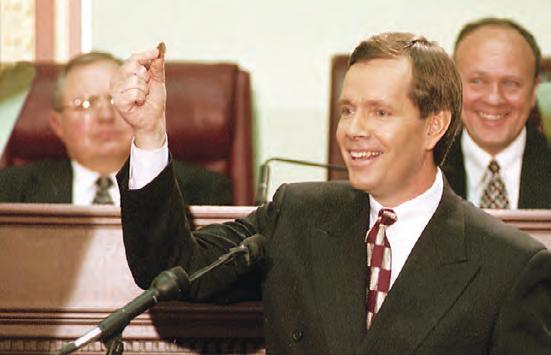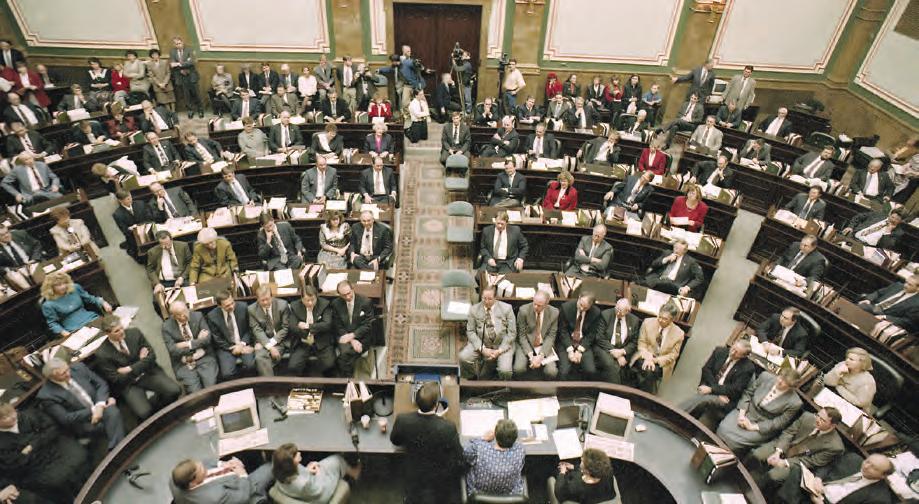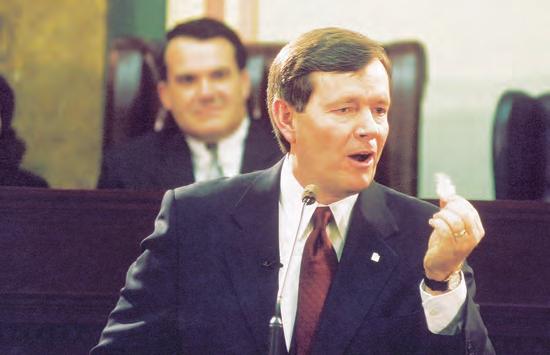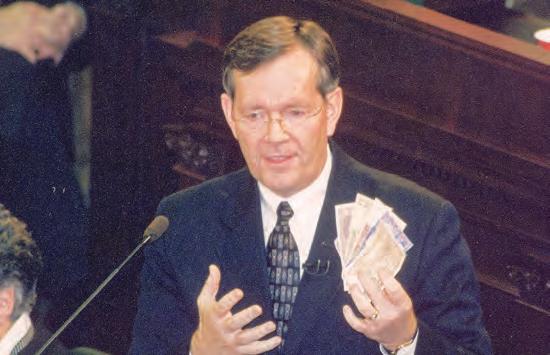
14 minute read
Chapter 10
from Real and Right
Speech Writing and Delivery
I have not kept a record of the speeches I have given over the past thirty years. For sheer curiosity’s sake, I wish I had. I have given thousands of speeches ranging from informal greetings at small gatherings to major speeches like State of the State or inaugural addresses. I have given policy speeches, technical speeches, commercial speeches, church speeches, commencement speeches, patriotic speeches, campaign speeches, etc.
I have spoken to audiences in more than sixty countries and had my words interpreted into more than twenty languages. The topics covered a wide range and had an equally broad array of objectives. How many, and which ones, did any good? That seems the best measure of a speech’s value—what objectives were furthered, what improvements were made, and whose lives changed for the better. A little, or a lot? It’s hard to know.
Speechmaking was certainly an important, visible aspect of being governor. The thousands of speeches I gave as governor—and afterward—fit into four basic categories: (1) formal written addresses for a specific audience on an appointed occasion; (2) talking points with quotes; (3) bullet-point outlines often personalized and polished on the fly; and (4) off the-cuff speeches covering very well-known subject matter.
The way I approach each of the four types of speeches have one thing in common—storytelling. Nearly every speech I give, long or short, formal or informal, written or off-the-cuff begins with a story, or gets to one quickly.
Audiences are engaged by stories and taught by stories. Starting with a story allows me to settle into a conversational mode, which is my style. Stories need not be long; in fact, the best stories leave texture and detail to the imagination of the listener.
Early in my first campaign I encountered Chuck Sellier, a best-selling author as well as a movie and television producer. He volunteered to do my television and radio commercials. In the process Chuck taught me, or at least explained to me, why stories are so important. “The goal,” he said, “is to tell stories that reach people in a ’guttural’ way.” By guttural he meant people would feel the emotions inside, and when they feel something they intuitively begin to fill in all kinds of details drawn from their own experiences.
The first time I worked with Chuck we talked for hours looking for the right story that would convey to people the essence of who I am. I told him about a lesson my Grandpa Okerlund taught me about sticking with reality.
“That’s it,” he said. “That’s the story we need.”
For the next two hours we worked through how to tell a fairly long story in the twenty-eight seconds available in a television commercial. This is what we came up with:
There was a farmer down the road from my grandpa who had more land than he could afford and a new John Deere tractor.
I said, “Grandpa, how can he do that?
“Mike,” my grandpa said, “If you stick with what is real and right, we will be farming long after he’s been repossessed.” That’s exactly what happened. A few months later his new tractor was gone and we were still farming.
“Real and Right—it’s what I teach my children and it’s the way I will govern this state.”
We called it “Real and Right.” Chuck surrounded it with wonderful visuals that helped tell the story, but I learned the lesson. Storytelling is essential to an effective speech.
Creative Processes
The way we set about creating speeches depended on the occasion. Only about two percent of all my speeches were the high-profile, formally delivered variety. These are the ones most associated with the traditions of government and the flourishes everything from the introduction itself to the use of a teleprompter, as well as the decorum and the setting. All of these were showpieces in a way, a presentation that had to have good visuals.
These kinds of speeches had a certain rhythm and flow, and a unique way of engaging with the audience. Many included highlighted guests, like the ones featured in all of the State of the Union addresses from President Reagan onward. Sometimes these folks are described as human props. We dubbed them “stunt babies,” due to a couple occasions when some of our most memorable State of the State honorees were young children. These types of speeches would be carried live on television and radio and had considerable press attention, so they had to draw the eye as well as the ear.
Nearly every speech I give, long or short, formal or informal, written or off-the-cuff begins with a story.
The speeches I call talking-points were a more workman-like, everyday model and had a threepart construction: An informal lead-in (almost always a short story or experience), a substantive middle abbreviated to a set of key points, and then a closing section of quotable stuff. Much of this was just hand-scrawled on a page with bullet points, with simple things that personalized the remarks to the situation or related to someone in the audience to spark interest from the start. The middle was always material I was very familiar with, with key words that triggered a longer, more substantive train of thought. The end quotes were meant to be the pithy, memorable encapsulation of it all, designed to be picked up by the media.
It is easier to get a new audience than a new speech.
Bullet-point speeches were an even more basic variation of talking-point speeches. I’d either write these up on my way to the venue or sit down a few minutes before speaking and assemble the points and the sequencing of what I would say. These two types of bullet-point or key-word speeches were the vast majority of all my speeches.
The fourth type were off-the-cuff speeches— those in which I was so familiar with the audience or subject matter that I could compose and deliver them on the spot without notes. The material was rarely new; it is just adapted somewhat for the circumstances—a rolling repertoire. You walk in and just unspool it. Second nature.
For all speeches, I subscribed to the notion someone in politics had coined: “It is easier to get a new audience than a new speech.” For those engaged in frequent public speaking, that is a fundamental truth. It is impossible for most people to compose a new speech for every occasion. Recycling not only works but it makes for better speeches. That holds true on other stages as well; plays start off-Broadway for a reason. There is no way to refine material without actually presenting it.
I used to feel uneasy about this. In time, I came to understand that repetition drives a point home and fosters retention. Some things bear repeating, whether it’s the handing down of a basic truth or a retelling of an old story. Some things we just like hearing again and again. When you go to a concert, the crowd applauds the new songs but erupts into cheers upon hearing the old favorites.
Political candidates have to have a stump speech they can repeat over and over with the same kind of enthusiasm. It reinforces the message and hones your own delivery. Along the way, it becomes more memorable. I’m convinced that Jesus Christ repeated his speeches often. How else would his disciples have the ability to record them with such exactness in the four gospels?
I was constantly carrying a series of speech modules in my head. Most of the time, these would be built around a story. I would use those until I sensed they were becoming stale, then out they went and a new set of stories was rotated in. Most of the stories came from personal experiences or observations. Life provides us with an abundant supply of great material.
More often than not I would write or compose most speeches in the last hour before it had to be given. This is a strange thing, but there is something about the pressure of the last minute that clarifies my thinking. Sometimes, I could think for days about a speech, but not finalize it in an outline until the last minute. That is the reason so many of my speeches were composed in the reporter notebooks I carried throughout my time in public service.
Formal Written Speeches
The inaugural and State of the State speeches were among the most important that I delivered as governor because I used them to chart a course for the state. The inauguration speeches set forth the values I wanted to foster; State of the State speeches laid out an agenda for the year and our continued vision. State of the State and the inaugural speeches were the most common formal speeches I gave, but events occasionally dictated the formality of some speeches, as was the case with the 2002 Olympics. When testifying before Congress, remarks had to be written and formal. Every word would become part of the Congressional record.
Major speeches were difficult for me. I have always felt compelled to be the primary drafter because it is hard for me to adopt the words of others as my own. At the root of it was the fact that I read formal speeches poorly out loud; it feels unnatural and oratorical, whereas my natural style is more conversational. This might have confounded some of my speechwriting partners (although one told me it was motivating).

Another reason I prefer to write my own speeches is that the writing process itself shapes my thinking and drives the internal mechanisms that help me reach conclusions. I’m not able to explain it better than that. There is something about the creative process that teases thoughts out of my head and leads to a determination. This is not just confined to speechmaking; whenever I have a major decision to make, I will inevitably write myself a memo. In the process, my thinking is given structure and I can examine it in a more deliberate way.
State of the State addresses became a significant part of the way my team and I consolidated our work plan. The process would start in September as we got serious about budgets. We would generally finish the budget right after Thanksgiving, giving us the necessary time to print budgets and plan announcements. With those decisions in hand, I would begin developing a detailed outline of what I wanted to say in the State of the State address. The outline would then be turned over to a colleague to create a draft and steer it through numerous edits. LaVarr Webb, Vicki Varela, Laurie Sullivan Maddox, Natalie Gochnour, and Therese Anderson each played that role at different times.
Once a draft was developed, I took the pen for a while. To me, there is something almost magical about having words on a page. I’m able to see what I want to say more clearly–especially once I see what I don’t want to say. Visualizing is the key. The drafts written by others didn’t need to be right; they just needed to be done. Somehow, that allowed me to work more fluidly.

Often my next draft would take the speech in a different direction. It was just the way the creative process worked for me. Then we’d pass it back and forth—many times. It was commonplace for there to be more than twenty drafts over the next thirty days.
State of the State speeches are challenging for several reasons, a big one being the gravity of the occasion among them. These speeches were also televised, and it was an important moment where I could speak directly to the people. Television stations always wanted it kept to thirty minutes. With applause and ceremonial trappings, it always ran longer.
I always used a teleprompter on the State of the State speeches and practiced them beforehand. Teleprompters help immensely by accompanying and keeping pace with you. That gave me the confidence and freedom to be more conversational in the delivery. To me, that is the key to public speaking. Be conversational; talk with people, not at them.
Another factor that made the speech challenging was that every department, constituency, and interest group looked for mention of their issue or project. There was an assumption that if the governor mentioned an issue in the State of the State, it was important. Finally, the speech needed to be entertaining for a television audience. Over time, I came to focus these speeches on my priorities and reaching two audiences: the public and the legislature.
Following my time as governor, I have worked as a contributor to the president’s State of the Union address. Presidents go through the same process as I did, and so do presidential candidates. No matter what the level, the process is similar, like when there are moments that you’re stuck on the umpteenth draft and think it’s going to be a disaster, and then suddenly, it crystallizes.
Recycling Works
There was no single speech that was a signature or a personal favorite for me. But I have to admit I loved the big formal speeches. It wasn’t just their excitement and preeminence, although those indeed set them apart. They were important in the continuum of history and had significance attached to the office and the times—and they are preserved by the state because of it. That’s hard to top.

I liked them too because these particular speeches, while stately, did not have to be spiritless, and were showcases for the character of Utah, as well as the mechanics of state government. These were the kinds of speeches where perfunctory interest in facts and figures could give way seconds later to raucous applause and a standing ovation.
Usually, the stunt babies instigated such moments. But one year, it was a seven-foot-four “stunt center” who stole the show.
In the 1996 State of the State, we wanted to emphasize the stultifying amount of federal welfare reform regulations, manuals, and guidelines requiring state compliance. We could just say there were a lot—or we could show it. We asked Utah Jazz center Mark Eaton if he’d be willing to make a cameo appearance to help demonstrate this particular folly. His response was: “Yeah, I’m there!” And so it was that the future NBA Hall of Famer stood in the well of the House, stacking reams of federal regulations sky high, visualizing the problem better than we could ever express it. It was a slam dunk that people remember to this day.

There were many other Utahns who helped personalize issues and episodes: Olympic athletes; the toddler “Bo” whose young life needed an assist from state’s Division of Child and Family Services; a seven-year-old girl whose reading ability five grades ahead attested to great parent and school collaboration; an unselfish couple who adopted five children to keep a group of foster siblings intact; and a unit of Utah National Guard Special Forces soldiers who were among the first called up after 9/11—and the first to sacrifice and fight against the Taliban in Afghanistan. They were awarded medals on the spot during the 2003 State of the State.
Everyday Utahns always brought down the house, and rightly so. To me, these moments epitomized Utah’s achievements and its aspirations, and recognized the best in all of us.











